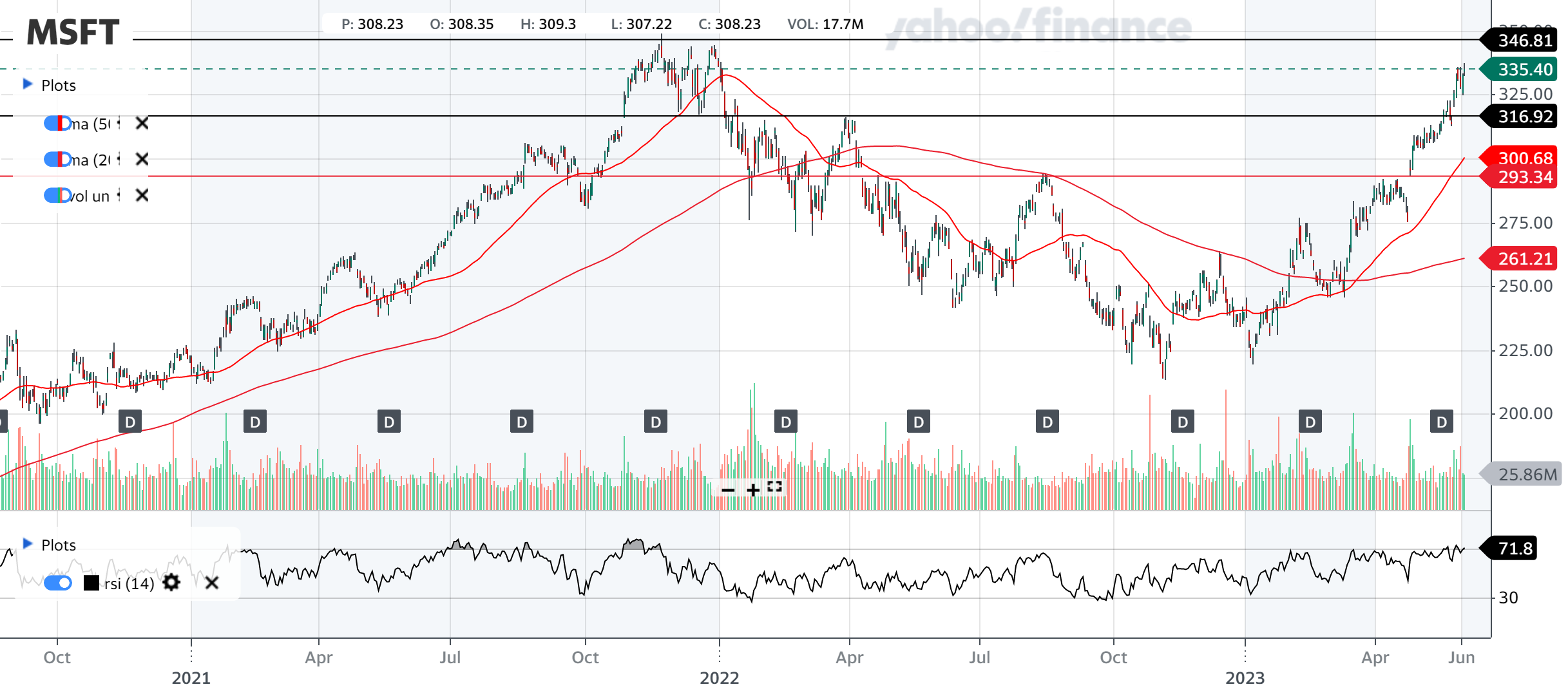Microsoft

Fundamental analysis
The American multinational software and technology company Microsoft was founded on April 4, 1975 by Bill Gates and Paul Allan. The company’s IPO was in 1986 and the subsequent stock price made 3 people dollar multi-billionaires and roughly 12,000 Microsoft employees became dollar millionaires.
Initially, the company focused on the development and sale of software, mainly the Windows operating system, and later also the Office suite of office applications. However, a narrow focus on a few products did not suit the company. Therefore, over the past 20 years, it has massively expanded its portfolio of services and products, either through its own development (Cloud services for business and private customers Azure and OneDrive, Office 365, Xbox gaming console) or by purchasing other companies (Skype, LinkedIn). Microsoft is also trying to create its own mobile devices, but it is not so successful in this field. This diversification is now paying off, with no segment accounting for more than 30% of sales and profits.
Microsoft itself divides its portfolio into three main segments, which are divided further. Their turnover and revenues for the year 2022 (year 2022 ends on 30.6.2022) are similar:
- Productivity and Business Processes: $63.364 billion
- Intelligent Cloud: $75.251 billion
- More Personal Computing: $59.655 billion
Total turnover: $198.270 billion, operating income $83.383 billion.
The results
Microsoft published results for 3Q 4/25/2023. Revenue increased 7% from Q3 2022. Operating profit increased 10% to $22.4 billion from Q3 2022. Net income increased 9% to $18.3 billion. The company is growing primarily on its newer products, especially the Cloud, where revenue is up a whopping 22% over Q3 2022 to $28.5 billion.
In its outlook for the future, Microsoft expects growth on almost all major products in the order of lower units of percent, Cloud expects growth by lower double digits. On the contrary, there will be a decline in sales of OEM Windows and mobile devices.
Technical analysis
According to moving averages, the company has been in an upward trend since mid-March. It has risen 24% since then. The RSI is therefore in an oversold sector after such a strong rise, giving us an opposite sell signal. The stock is currently near its two-year high at around $340 per share. This can be a strong resistance.
The company’s volume is high, over 25 million shares are traded daily. Liquidity is therefore sufficient.
Conclusion
Microsoft is no longer just a Windows operating system. On the contrary, it is rather a company offering complex cloud services, and the Windows operating system is more and more on the decline. The investment and diversification into these new products has obviously paid off. The share price has increased by more than 800% in the last 10 years, including the covid crash. It is very impressive that the company is able to grow by tens of percent in these new markets, even though there are many other players in the market that offer cloud services. The company expects an overall increase in sales and further development of new services, especially AI.
On the contrary, some investors may be discouraged by a higher share price that is close to its maximum or conflicting signals from technical analysis.
Resources:
https://www.microsoft.com/en-us/Investor/earnings/FY-2022-Q4/segment-revenues
https://view.officeapps.live.com/op/view.aspx?src=https://www.microsoft.com/en-us/CMSFiles/PressReleaseFY23Q3.docx?version=00675292-f4c7-c73f-1d56- ce95aef906dd
https://view.officeapps.live.com/op/view.aspx?src=https://www.microsoft.com/en-us/CMSFiles/SlidesFY23Q3.pptx?version=2c277cca-d387-2608-f0ce- fc7f8ab4214c
https://view.officeapps.live.com/op/view.aspx?src=https://www.microsoft.com/en-us/CMSFiles/OutlookFY23Q3.pptx?version=de2602b1-e48e-0c89-724b- df5a2b9702e0
https://seekingalpha.com/symbol/MSFT
https://simplywall.st/stocks/us/software/nasdaq-msft/microsoft/information
https://finance.yahoo.com/quote/MSFT?p=MSFT
https://en.wikipedia.org/wiki/Microsoft